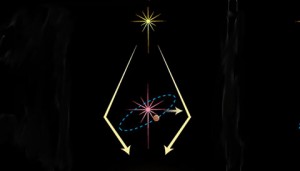Why are there two peaks in the light curve on page 97 of the October 2005 issue? One might imagine that a planet of the star would produce only one sharp peak on the rounded dashed line. But why two?

NASA / ESA / A. Feild (STScI)
This is an insightful question, because astronomers who use the gravitational microlensing method to find extrasolar planets (the subject of our article) will indeed, in certain circumstances, see a single sharp peak added to the light curve. But as the saying goes, the devil’s in the details. In this case, the details have to do with geometry. When a foreground star passes directly between Earth and a much more distant background star, Einstein’s general theory of relativity predicts that the foreground star will act as a gravitational lens; it will “bend” certain light rays from the background star that would otherwise miss Earth and redirect them toward Earth. This effect causes the background star to brighten until it reaches a single peak and then fade in a characteristic, symmetrical pattern.
But a planet added to this simple picture can break the symmetry, as in the case of the microlensing event OGLE-2005-BLG-071 described in the article. Instead of seeing a single peak, the multinational group of astronomers detected a brief dip in the light curve because the lensing star’s planet, moving in its orbit, diverted some of the background star’s light rays and caused them to miss Earth.
In other circumstances, however, a planet in orbit around a lensing star could redirect more of the background star’s light toward Earth, adding to the lensing effect produced by the planet’s host star. In these cases, astronomers would see a sharp spike added to a microlensing light curve. The shape of the light curve depends on the exact alignment of the background star, the lensing star, the planet, and Earth. (I thank Scott Gaudi of the Harvard-Smithsonian Center for Astrophysics for his help in answering this question.)
— Robert Naeye
 0
0
Comments
You must be logged in to post a comment.